

Jon Clements, Author (unless otherwise noted) and Editor
Note: current (August 7) DD Base 43 BE accumulation, Belchertown, MA = 2675
| Coming events | Degree days (Base 43 BE) |
| Apple maggot flight peak | 2118-2638 |
| Codling moth 2nd flight peak | 1948-2693 |
| Lesser appleworm 2nd flight peak | 2144-3071 |
| Obliquebanded leafroller 2nd flight start | 2235-2634 |
| Oriental fruit moth 3rd flight starts | 2263-2821 |
| Redbanded leafroller 3rd flight starts | 2523-2821 |
| San Jose scale 2nd flight peak | 2137-2493 |
| Spotted tentiform leafminer 3r generation flight peak | 2561-3002 |
| White apple leafhopper 1st brood adults subside | 2195-2521 |
*Adapted from Scaffolds Fruit Journal
Note: this will be the last Upcoming pest events for 2017
Key insect life cycle and management dates and preliminary McIntosh harvest date forecasts
Note: for 2017, we have four Massachusetts orchard locations subscribed to AR: Amherst, Belchertown, Deerfield, and Easthampton. The website for looking at AgRadar for these locations is: http://extension.umaine.edu/ipm/ag-radar-apple-sites/. What follows is the AgRadar summary for the Belchertown location.
Apple Maggot Fly AMF -- Rough guess of peak AM trap captures is: August 3, Thursday.
Codling moth CM -- 2nd generation 7% CM egg hatch: July 28, Friday, = target date for first spray where multiple sprays needed to control 2nd generation CM. 2nd generation 30% CM egg hatch: August 7, Monday, = target date where one spray needed to control 2nd generation CM.
White Apple Leafhopper WAL -- 2nd generation WAL found on apple foliage: August 4, Friday
Preliminary McIntosh harvest date forecast -- Date to apply ReTain to delay first harvest for apples which without treatment would be ready for storage harvest on September 2 is from Saturday August 5 to August 12. Date to apply ReTain to delay maturity for 2nd, 3rd or 4th pick of those apples, without delaying start of harvest maturity, is from Saturday, August 19 to August 26. Begin measuring actual McIntosh starch-iodine index no later than Saturday, August 26. The Michigan formula estimates that non-spur McIntosh will reach starch index 4.0 and start the optimum harvest window for long term storage on Saturday, September 2. Using the Hudson Valley NY formula, McIntosh maturity is forecast to reach starch index 6.0 in Belchertown MA on Saturday, September 23.
Note: this will be the last AgRadar for 2017
Jon Clements
We are up to our eyeballs with peach harvest here at the UMass Orchard. Redhaven is just about ready to be picked, signaling the brunt of the peach harvest season, however, it will go well into early September. Spotted wing drosophila (SWD) are easy to find in damaged/rotten/dropped peaches, and particularly nectarines. (Does anyone really like to grow nectarines?) Our best advice is to pick just barely tree ripe fruit ASAP, practice sanitation (remove rotten fruit) to the best extent possible, and seriously consider insecticide applications for SWD (Delegate, 1 day PHI or Exirel, 3 day PHI -- do not mix with Captan) if you get behind on harvest. SWD has been observed on sound fruit, so it's likely they are laying eggs and infesting good, otherwise sound fruit. Here are SWD insecticide recommendations for stone fruit...and BTW, if anyone has any evidence of SWD larvae in otherwise sound fruit, please let us know!
Apple maggot fly (AMF) catch on a yellow sticky trap peaked early last week. They are out there, but should be on the decline, perhaps one more AMF insecticide spray necessary in most orchards. Imidan, Delegate, Assail or Exirel are good choices. (Note that Exirel should not be tank-mixed with Captan!)
Believe it or not, according to AgRadar in Belchertown the "Date to apply ReTain® to delay first harvest for apples which without treatment would be ready for storage harvest on September 2 is from Saturday August 5 to August 12." Yes, that is this week, however, there is some opportunity there to go a little later. I have compiled a bunch of good resources/articles in Horticulture on ReTain (and other options) for stop-drop control in apples, including Duane Greene's observations. Note that ReTain can also be used on peaches.
A few fresh notes from the field (today), Liz Garofalo (@HawkEyeIPM https://twitter.com/HawkEyeIPM):
Fire blight observed: recommendation, cut out where feasible, apply strep if trauma event (50 day PHI), avoid excessive vigor in trees
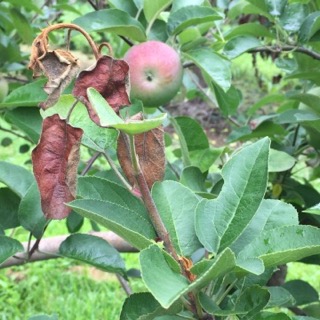 |
 |
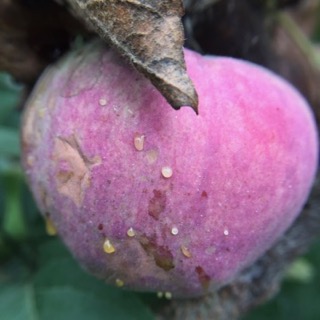 |
 |
Bitter rot symptoms are showing up. Captan at the higher label rate will give you good protection while also burning out any active scab you may have floating around this year. (Do not tank mix Captan with Exirel.) Bitter rot has the potential to become problematic under hot wet conditions. Luckily, it looks like the temperatures will remain at 80 or below for the foreseeable future, however, the NOAA 30-day outlook is for greater chance of above normal temperatures for the rest of August. |
| Dogwood borer are still out and about in apple orchards. Dwarf rootstocks with burr knots are particularly at risk. An earlier application of Lorsban to tree trunks (28 day PHI, only one application allowed) or deploying mating disruption is about all you can do at this time (until next year). Oh, and keeping the trunks free of weeds and debris is a good idea... | 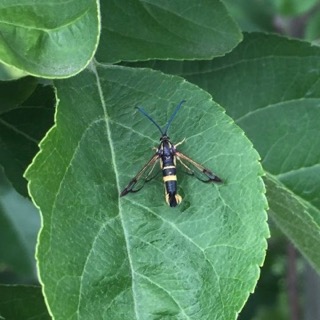 |
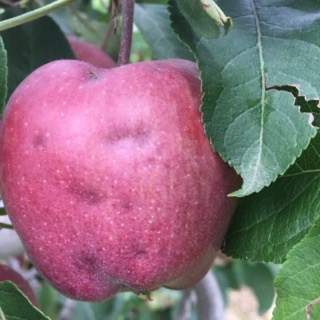 |
Stink bug injury? Maybe? A reminder that native stink bugs definitely pose a risk to peaches and apples -- like this onespotted stink bug (right) found in a peach block at the UMass Orchard. A grower also reported what appeared to be significant stink bug injury in Brock apples recently. Maintaining some insecticide coverage for the next few weeks is not a bad idea if you think you have a problem with this pest. So far we have found no Brown Marmorated Stink Bug in our fairly extensive BMSB trapping network...although a consultant has reported trapping a few in two orchards. |  |
Duane Greene
General comments on pre-harvest drop control for 2017
The weather during the 2017 growing season can be characterized as having adequate moisture and temperatures that are close to average. Weather conditions such as these are not very stressful for apple trees and consequently I anticipate an "average" need for pre-harvest drop control this season. ReTain remains our most important commercial drop control compound. It was first registered for use to control preharvest drop and to aid harvest management 20 years ago. Most growers have had sufficient experience over this period of time to figure out the amount, timing and number of application that work most effectively in their circumstance and variety mix. Harvista is gaining in popularity but AgroFresh is continually working to fine-tune its application technology recommendations for use. This process is being worked out in-house by AgroFresh and is an ongoing project.
NAA is a drop control compound that is used far less frequently since it is effective for only about 12 to 14 days even with a double application and it is known to have the potential to result in fruit softening. This is particularly true when used on McIntosh types. However, I recommend NAA as the product of choice when combined with Ethrel to advance ripening. Ethrel is applied to increase red color and advance ripening. NAA (Fruitone) may be used at a rate of 10 to 20 ppm. It may be included initially in with the Ethrel spray or applied 3 to 4 days later. A delay in application does give growers additional drop control later, but if a period of rainy hot weather move in and prevents application of the NAA in a timely manner, extensive losses could result from excessive drop.
Cortland-specific recommendation
For the past couple of years we have been looking at the benefits of using high rates of ReTain on Cortland apples. Although Cortland is not a cultivar that has a drop problems it does respond extremely well to ReTain application. Observations made over the past several years showed that ReTain can delay ripening allowing maturation to occur slower during the cooler weather in October. There can be some reduction in red color development early but this is more than compensated for by improved coloring weather experienced later. The advantages of using high rates of ReTain is that fruit quality is substantially increased while still maintaining condition. I am suggesting using 1 pouch of ReTain applied 4 weeks before anticipated harvest and a second 1 pouch application 2 to 2.5 weeks later. Treated fruit should be harvest a little later. At harvest, the taste of treated Cortland is outstanding. Reduction in red color is not a problem if allowed to remain on the tree a little longer. If fruit are harvested and treated with SmartFresh they will store longer and keep outstanding condition and flavor. Two years ago ReTain treated Cortland receiving SmartFresh alone had two pounds greater flesh firmness than fruit just receiving SmartFresh when evaluated out of storage. This is a strategy that shows great promise to allow growers to present customers a very high quality Cortland apple in October and beyond.
Delay ripening of Honeycrisp and Gala
It is widely acknowledged that application of ReTain on Gala and Honeycrisp should generally be restricted to about a half pouch rate per acre to avoid excessive delay in red color development and ripening. There have been reports that ReTain rates as high as two pouches per acre applied as a split application may have commercial potential. In New England, McIntosh, Honeycrisp and Gala more-or-less ripen at the same time. There are circumstances (pick-your-own, efficient harvest management, improved fruit quality) where delay of ripening of some of these is beneficial. Last year we applied 2 pouches of ReTain on Gala and Honeycrisp; one 3 weeks before anticipated harvest and then a second 2 weeks later. Fruit were harvested on about October 15. Honeycrisp had high color and quality and there was no prehavest drop. Gala fruit were also well colored and of high quality when harvested in the middle of October. However, last year was a difficult drop control year, due to high temperature and drought conditions and this may have been an anomaly. We hope to test this again this year during a more “normal” growing season.
Ed. note: here are some more articles/references on ReTain/stop-drop control applications. Also see Guest article below.
Apple Preharvest-Drop-Control Sprays (James Schupp, Penn State)
ReTain Label (Agrian)
Retain Supplemental Label - 48 States or Territories - FOR USE ON APPLE & PEAR (Agrian, single and double application)
No Guest article this week, however, see Win Cowgill's recent reports and recommendations on ReTain (particularly double application) and stop-drop for 2017. (Thanks Win for sharing...)
2017 - Double Applications of ReTain to provide longer fruit drop control compared to the standard single application ReTain (Win Cowgill- Professor Emeritus Win Enterprises International, LLC)
Harvest Maturity and When to Apply Retain for Harvest Management (Win Cowgill with some help from My Friends)
Follow me (jmcextman) on FB: https://www.facebook.com/jmcextman
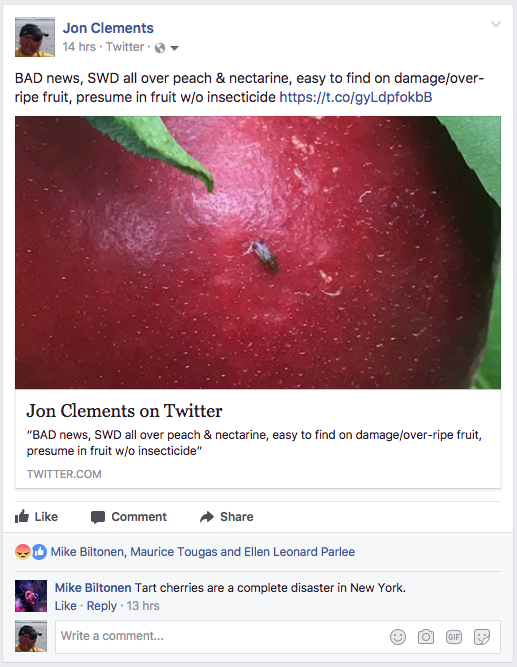
New England Tree Fruit Management Guide
UMass Fruit Advisor: http://umassfruit.com
Scaffolds Fruit Journal: http://www.nysaes.cornell.edu/ent/scafolds/
Network for Environment and Weather Applications (NEWA): http://newa.cornell.edu
Follow me on Twitter (http://twitter.com/jmcextman) and Facebook (http://www.facebook.com/jmcextman)
The next Healthy Fruit (which will be primarily the first apple maturity report) will be published on Tuesday, August 22, or thereabouts, 2017. As always feel free to get in touch with any member of the UMass Fruit Team (http://extension.umass.edu/fruitadvisor/team-members) if you have questions or comments.